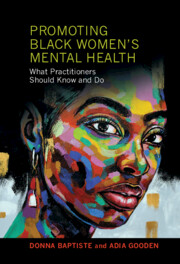Book contents
- Promoting Black Women’s Mental Health
- Promoting Black Women’s Mental Health
- Copyright page
- Contents
- Figures
- Tables
- Contributors
- Introduction
- Part I Black Women in Context
- 1 A Study of Black Women and Psychotherapy
- 2 Social Determinants of Health and Mental Health for Black Women
- 3 Black Girlhood: Developmental Experiences of Black Women
- 4 Stereotypes of Black Women: Clinical Implications
- 5 Black Women and Trauma
- Part II Therapy Contexts
- Part III Core Themes in Black Women’s Stress and Distress
- Part IV Helping Black Women Recover and Thrive
- Appendix
- Index
- References
2 - Social Determinants of Health and Mental Health for Black Women
from Part I - Black Women in Context
Published online by Cambridge University Press: 22 June 2023
- Promoting Black Women’s Mental Health
- Promoting Black Women’s Mental Health
- Copyright page
- Contents
- Figures
- Tables
- Contributors
- Introduction
- Part I Black Women in Context
- 1 A Study of Black Women and Psychotherapy
- 2 Social Determinants of Health and Mental Health for Black Women
- 3 Black Girlhood: Developmental Experiences of Black Women
- 4 Stereotypes of Black Women: Clinical Implications
- 5 Black Women and Trauma
- Part II Therapy Contexts
- Part III Core Themes in Black Women’s Stress and Distress
- Part IV Helping Black Women Recover and Thrive
- Appendix
- Index
- References
Summary
Drawing on public health and psychological research and scholarship, we provide an overview of the historical, social, political, and economic experiences that impact the mental health and wellness of Black women in America. We explore Black women’s statuses driven by racial, ethnic, sex/gender, social class, and other disparities. Using a social determinants of health framework We highlight the ways that systemic inequities interact with biological predispositions to shape Black women’s health and mental health. We discuss how Black women’s social group statuses create challenging conditions that induce mental and emotional symptoms such as mood and anxiety disorders. We utilize a case example to illustrate how these interacting forces might play out in one Black woman’s life.
- Type
- Chapter
- Information
- Promoting Black Women's Mental HealthWhat Practitioners Should Know and Do, pp. 41 - 64Publisher: Cambridge University PressPrint publication year: 2023

